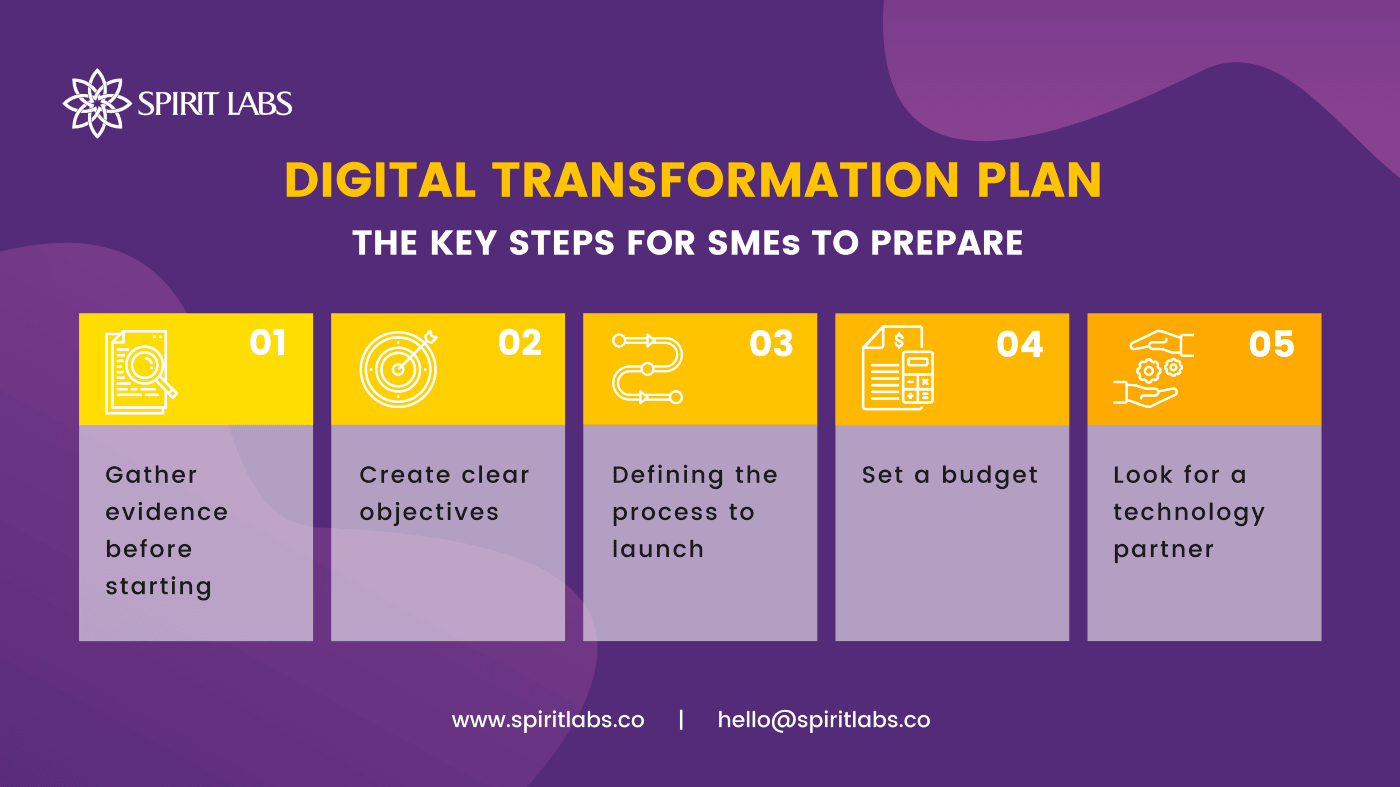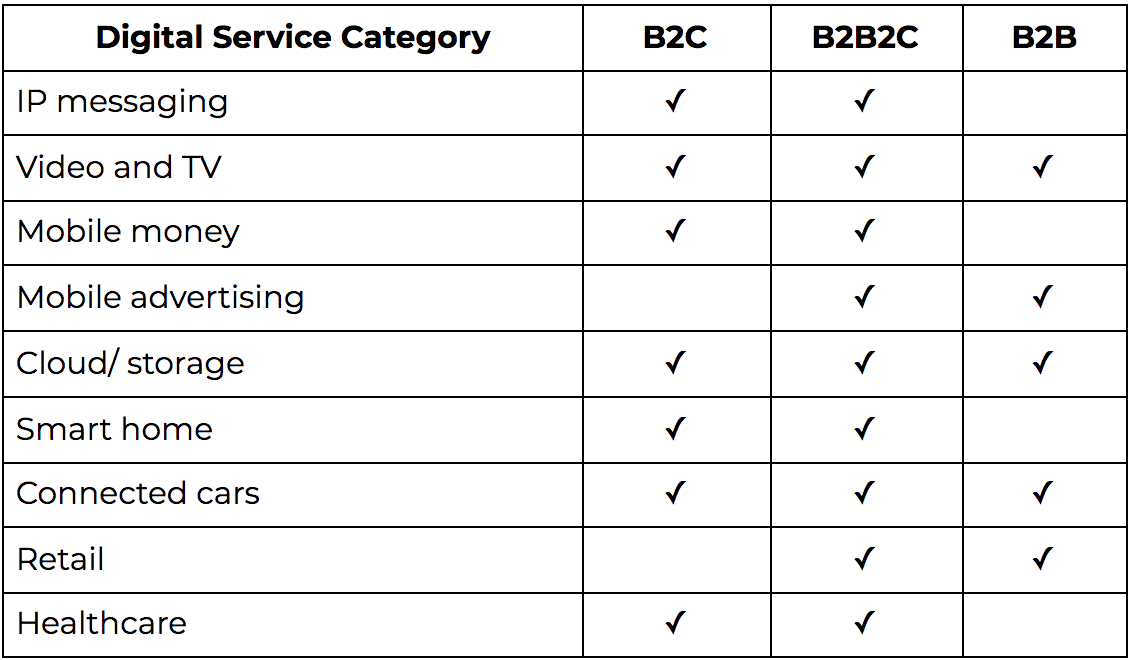
Build your Digital Transformation Plan: The key steps for SMEs to prepare
Digital transformation has become a concentration of every company. In general, It’s the process of transforming every aspect of a business such as management system, work system from traditional to digital. Digital transformation can provide businesses with enormous competitive advantages, however businesses need a clear digital transformation plan to get it done successfully.
Read more about digital transformation and its advantages at: https://spiritlabs.co/blog/How-does-Digital-Transformation-affect-SMEs
“A digital transformation plan is a long-term strategic plan that focuses on integrated digital media channels, new technology implementation, and smart, digital ways of working.”
Your digital transformation plan is the strategy for coordinating and driving change across your organization. Each business is unique, as are the scope and effort required to achieve digital transformation. Your digital transformation plan will move at a different pace depending on how your company manages projects, programs, and investment decisions.
Digital transformation is not just about adding a website or a mobile app, or randomly applying digital technologies here and there; This transformation will affect every aspect of an organization. It comprises a series of structural changes that transform an entire organization’s future business. Major layers of digital transformation plan consist of: business transformation, operations transformation, and infrastructure transformation
Business transformation refers to the re-design of an operator’s strategic position in the digital ecosystem, services portfolio and business models. Starting with an understanding of the outside-in customer perspective, operators must first define their digital ambitions and goals to determine what role they want to play in the digital ecosystem. Nevertheless, in an increasingly diverse market landscape, operators’ positioning in a digital ecosystem will diverge due to differences in the level of digital ambition, current digital maturity, contrasting prioritizations of growth and efficiency within their business agenda.
Some common business models that operators adopt for various digital services today. Governments, education, healthcare, public infrastructure, finance, and media sectors are some early examples of sectors that have committed to going digital.

Operations transformation refers to the restructuring of an operator’s operating model and capabilities that enables an effective execution of the future business models, facilitates a new way of customer interactions along the journey with the customer, and to deliver the ROADS experience. The ultimate goal is to redesign the operating model from “Big” to “Fast”, where the emphasis of capacity will move toward agility. The future operating model of an operator consists of a business capability blueprint with front-end capabilities, core capabilities and back-end capabilities that enable customer-centric and agile operations. Agility will be vital for operators as they are in battle with digital natives in a dynamic market environment.
Demands and a business landscape will be significantly different from today so operators need an ICT(information and communications technology) infrastructure that is programmable and highly automated to be able to respond quickly to various demands.
For example, there will be increasing use cases that require bandwidth on demand as customers choose to access services online anytime they require. The ICT infrastructure would need to be flexible to offer self-configuration, auto-allocation of resources, and virtualize a pool of resources. To achieve this, a full reconstruction of ICT infrastructure including equipment, network, services, and operations is necessary to enhance network efficiency and agile operations effectiveness.
It is critical to gather evidence before embarking on a new journey. However, in business, we frequently start a project without evidence.
Begin by identifying the ‘where are you now?’ question to ensure the success of your digital transformation strategy. This provides you with benchmark data that you can use later. Typically, you would get over the following questions:
- What are your digital advantages and disadvantages?
- What are your primary competitors or comparable organizations doing?
- What’s on the horizon? This information is frequently not available online because it is a ‘work in progress.’
After the audit stage is complete, it’s important to understand what your organization’s goals are. Are there any specific goals? Is there a future milestone that is driving business practice? Or has your company begun to notice that it is falling behind?
Use a model or a roadmap to get to the next step. As a tool for developing business objectives, 5S marketing goals is the one to be considered . This is due to the fact that many objectives focus on the numbers, which is necessary, but it ignores other factors. The 5Ss is an easy-to-use ‘objective generator’ that was originally designed as a website review tool.
At this stage, strategizing puts you in control of any upcoming actions. You should break it into small periods, prioritizing each area of improvement by importance levels so that you can stay on track and avoid making mistakes.
A clear vision
In the past companies had ‘mission statements’ that were so long, they were printed onto the back of business cards as an aide-memoire! Today your vision has to be clear, memorable, and succinct.
A training session
Digital transformation can affect your company culture, on how the business works before. According to a study performed by the SMB Group in 2018, employee resistance to change was a “top obstacle” for SME executives when trying to adopt a digital transformation strategy. As a result, you’ll need a strategy to integrate departments, focus on training, and disseminate information about how technology will affect workflow in the future so that no one is confused and everyone is working toward a new goal, increased technology adoption.
To put your digital transformation strategy into action, you’ll need to invest a significant amount of money. You need to carefully divide up your budget.
Focus spending on areas such as data analytics, cloud computing, business processes and customer experience. Aim to streamline time-consuming and repetitive tasks. Look at how digital transformation will make existing processes more affordable in the long run. Many small businesses also prefer to use simple tools with high impact, such as cloud-based accounting or CRM systems.
Hiring the large IT Team may not be a financially sound decision for SMEs due to the limited budget. Instead, it’s wise to consider finding a digital solution partner, a software company or an IT provider that provides the affordable pricing models and intensive business experience combined with technology savvy to consult and help build your digital transformation plan.
This article discusses the Digital Transformation Plan for every business to gain competitive advantages. We hope you’ve found the information you need to start the planning process.
References:
- https://www.smartinsights.com/manage-digital-transformation/digital-transformation-strategy/structure-effective-digital-transformation-plan/
- https://www.file.huawei.com/-/media/corporate/pdf/white%20paper/developing-a-smart-transformation-plan.pdf
- https://www.smartinsights.com/manage-digital-transformation/digital-transformation-strategy/digital-transformation-plan/


